Meet the Women Who Catch Python Snakes in the Everglades Every Night
Updated: Nov. 27, 2022
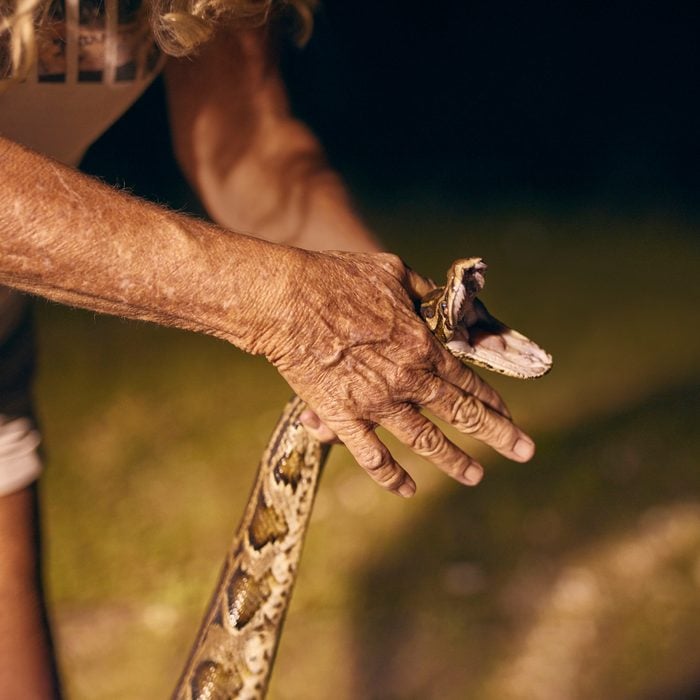
Invasive Burmese pythons are squeezing the life out of the Everglades. An unlikely sisterhood of the swamp is taking them on.
For Beth Koehler and Peggy Van Gorder, this is how it works: Three days a week they run Hair of the Dog, their dog grooming salon in St. Petersburg, Florida. Then they close up shop, pick up their camper, and head down to the Everglades for three nights of hunting Burmese pythons—powerful constrictors that squeeze the life out of their prey.
Each night of the hunt, they spend hours slowly rolling along gravel back roads searching for the elusive invasive reptiles. They switch on massive lights atop their Jeep, lights that turn the night as bright as day. The humid air is filled with a subdued chorus of hoots and ribbits.
The younger, more athletic Van Gorder drives, never going more than about 6 mph, while Koehler, the more focused of the two, stands with her head through the sunroof, peering ahead for any sign of a snake.
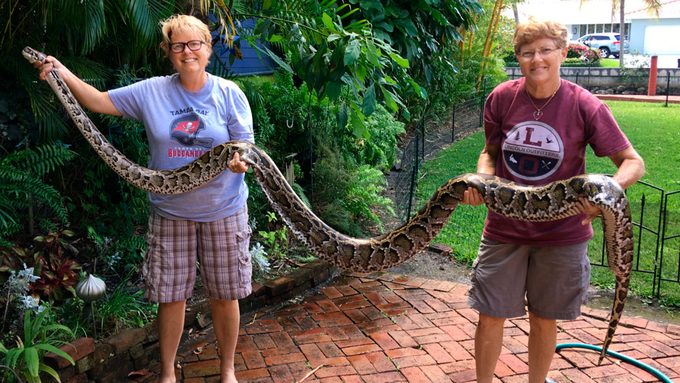
The pair, known to their fellow python hunters as PegBeth, achieved some statewide fame in 2019 when they bagged the 500th python to be caught by hunters working for the Florida Fish and Wildlife Conservation Commission. They’re not doing it for the money; there’s hardly any profit in searching for the slithery invaders. The job pays $8.46 an hour plus $50 per snake, with another $25-per-foot bonus for snakes longer than four feet. Some nights the pair comes up empty, meaning they are basically making minimum wage.
No, it’s not for the money. They’re doing it to save Florida’s wildlife.
The first Burmese python turned up on the outskirts of Everglades National Park in 1979. It measured 11 feet, 9 inches, and had been flattened by a car. By the late 1990s, a National Park Service biologist named Ray “Skip” Snow sounded the alarm about pythons taking over the Everglades. No one took his warnings seriously because he had no proof that pythons were mating in the wild. In 2003, he finally found hatchlings, incontrovertible evidence of breeding—only to be told by the people in charge that it was now too late to stop the snakes.
Today, biologists estimate that about 100,000 pythons infest Everglades National Park, Big Cypress National Preserve, and the thousands of acres of marshy public land surrounding them. But they’re not staying put. CNN reported that a woman in West Palm Beach found a Burmese python in her washing machine. The problem has gotten so bad that in February, the state’s Fish and Wildlife Conservation Commission banned possession and breeding of Burmese pythons and 15 other nonnative species.
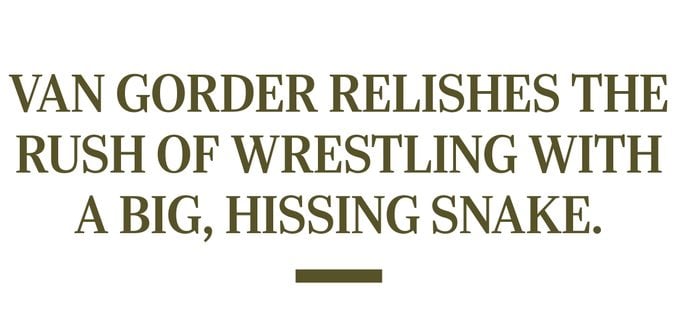
“I grew up down here,” Koehler, 61, says. “I’ve seen the changes that have taken place. And now, all you’re going to see are rats, gators, and pythons … That’s why they have to be taken out.”
While some hunters take out the snakes with bullets, Koehler and Van Gorder prefer to nab them by hand and stuff them into large sacks. Van Gorder, an Army brat who grew up all over the place, says she relishes the adrenaline rush of wrestling with a big, hissing snake. Once, she was bitten on the hand by a struggling python. The snake’s tooth remained lodged in her finger for months. It didn’t lessen her enthusiasm for the hunt.
“We want to get our adventure in now,” the 55-year-old says. “I can sit on a cruise ship when I’m an old lady.”
To the public, the face of Florida’s python hunters is Dusty “Wildman” Crum, who once caught a python that measured 16 feet, 11 inches long. The folksy, thick-bearded Crum stars in the Discovery Channel’s Guardians of the Glades, where he runs through the swamps barefoot, showing little apparent regard for the gators, feral hogs, and venomous native snakes that also occupy the soggy terrain. The truth is, though, Florida’s licensed python hunters come in all shapes and sizes. Quite a few are female. One of the best is Anne Gorden-Vega.
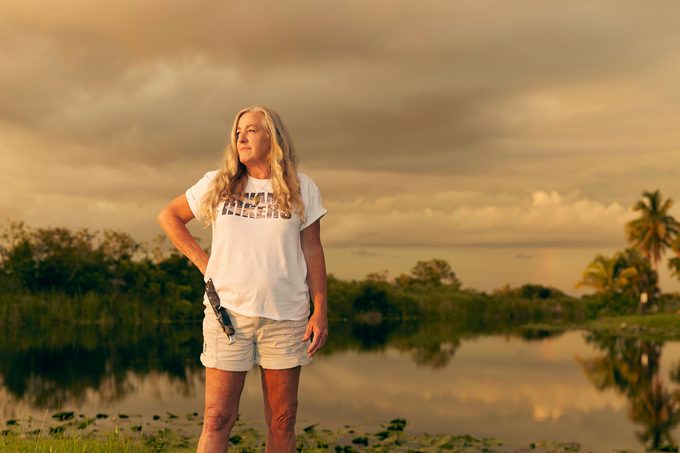
Gorden-Vega’s LinkedIn profile describes her as a teacher at the Ceramic League of Miami and an artist who specializes in hand-carved tiles, sculpture, and raku firing. What LinkedIn doesn’t mention is that the vivacious 62-year-old with long silver hair has caught 236 pythons for the state.
Gorden-Vega grew up hiking around the Everglades, watching the animals. She gave it up when she became a mom, trading in her nature hikes for nine years as a soccer coach. Then one day, one of her art students mentioned she was going python hunting with a state contractor. Gorden-Vega finagled an invitation to tag along, and before she knew it, “Monday became ladies’ night out,” she says. “We’d drive around the swamp laughing our butts off.”
She noticed, though, that these expeditions were different from the nature hikes of her youth. She saw no raccoons or foxes or any other small mammals. The pythons had eaten them. A 2012 scientific study found that between 2003 and 2011, the areas where pythons had proliferated saw a 99 percent decrease in raccoon populations, a 98 percent drop in opossums, a 94 percent drop in white-tailed deer, and an 87 percent falloff for bobcats. The number for rabbits and foxes: 100 percent.
RELATED: This Man Beheaded a Snake—And It Still Bit Him
The pythons’ effect on the landscape made Gorden-Vega want to do more snake catching. She and her art student, a 59-year-old stay-at-home mom, filled out applications with the Florida Fish and Wildlife Conservation Commission but figured they had zero chance of being selected. Of the 40 snake hunters the commission employs, only ten are women. To their surprise, both women were hired.
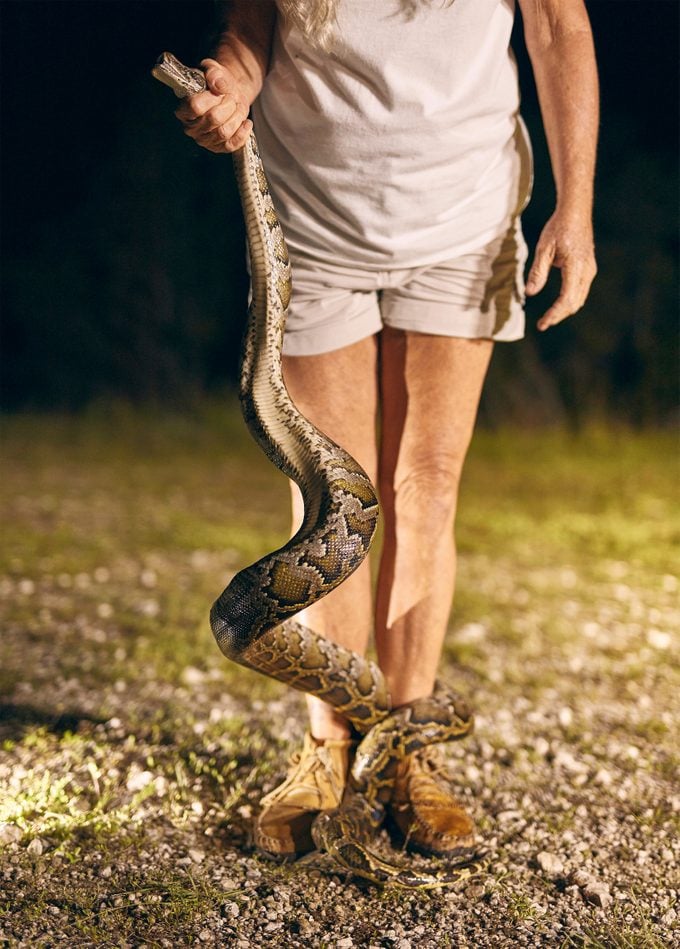
“I looked at her and said, ‘They’re desperate,’ ” says Gorden-Vega.
When Gorden-Vega goes hunting, sometimes she’ll let a friend or a licensed hunter from out of town tag along. Other times, she goes out alone, leaving her husband, a service technician for AT&T, at home as she cruises the levees. She drives a 2017 Chevy Colorado ZR2 with four-wheel drive and bright LED lights on top. The truck has what she calls “99,000 python miles” on the odometer. She burns a lot of gas patrolling the levees half the night. She fills the silence by listening to audiobooks, mostly “historical fiction, anything about Florida, murder mysteries, weird stuff. It’s fun being out in the Glades and listening to stories about the Everglades.”
Gorden-Vega figures her best tool for catching pythons is the element of surprise. The pythons are used to being the apex predator, so when she grabs one by the head, the snake is too stunned to react. That gives her a chance to stuff it into a bag.
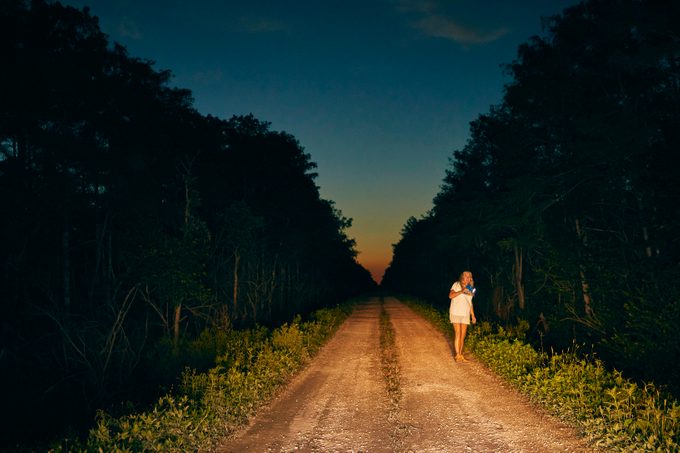
If it puts up a struggle, the wrestling match usually takes about 15 minutes, on rare occasions up to an hour. She just lies down on the snake, digs in with her elbows, and wears the thing out. Sometimes the pythons fight back in a very messy way, peeing and pooping on her.
“We call that the sweet smell of success,” she says, “because you smell that way because you got one.”
Donna Kalil does not call herself a python hunter. Instead, she’s a “python elimination specialist.” She wears a python-skin hat. Her Ford Expedition has python-skin seat covers and a custom-made “Python Perch” on the roof. Once, when she gave a speech at a conference, her daughter Deanna made cookies for the audience using python eggs.
“This has taken over my life,” Kalil says.
Kalil collected snakes and lizards as a kid. She sold Florida real estate in the 1980s. In 2017, she became the first female python hunter hired by the South Florida Water Management District. She was going to try it for three months. Four years later, the five-foot-ten, 125-pound Kalil was one of a handful licensed to hunt pythons for both the water district and the wildlife commission, meaning she has access to land owned by both agencies.
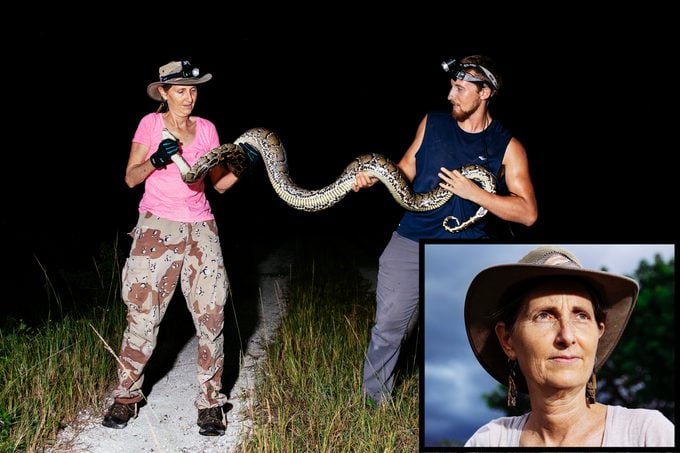
When hunters working for the wildlife commission catch pythons, they take them to a state laboratory in Davie. Some pythons are killed with a bolt gun and dissected for examination. Some are injected with a microchip for tracking and turned loose so they will lead the hunters and researchers to other snakes.
At least, that’s the way it’s supposed to work. During the coronavirus pandemic, the rules changed. The lab was no longer open to visiting hunters. Instead, hunters had to euthanize their snakes and do virtual measuring and weighing with an app.
Killing the snakes is the hardest aspect of the job for Kalil, who believes in killing animals only if you’re going to eat them. The first one she killed was a little one, just 4½ feet long. She stabbed it in the head.
“I cried for a good long time,” she says. Even now, “I can’t look them in the eyes. And I apologize to them for what I’m about to do to them.”
One nearly got the better of her. She was grappling with a 7½-footer when her daughter called. Rather than let the call go to voice mail, Kalil tried to answer it.
“It was a silly mistake,” she says.
With Kalil distracted, the snake wrapped itself around her neck. She couldn’t get the leverage to pull it loose, so she had to stagger back to her truck, where some friends were packing up their gear, and tap one on the back. Her friends got the snake off of her before she passed out.
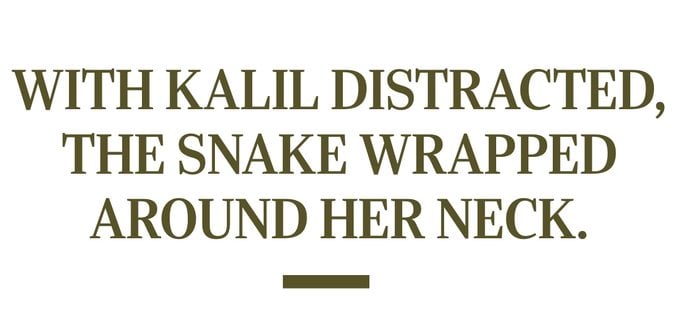
Kalil hasn’t saved any other hunters, but she has rescued a couple of alligators that were losing battles with pythons. She has also caught a python that had already swallowed a gator.
Kalil has captured more than 500 pythons so far, including more than one “mating ball” made up of multiple snakes tangled together during breeding season. The biggest python she’s caught by herself was 12½ feet long. The biggest one she nabbed with assistance was a 15½-footer.
When she started out as the lone woman working for the water district, no one showed her the ropes, she says. “Their attitude was, ‘I learned the hard way, so you should have to learn the hard way too.’ ” Kalil takes the opposite approach, helping new hunters learn the right way to catch pythons. “I don’t want to see a bunch of guys coming out here shooting up the Everglades because they think the only good snake is a dead snake.”
Amy Siewe abandoned a successful career in real estate in Indiana to become a python hunter.
“I have this insane passion for snakes,” says Siewe. “I can’t explain it.”
When she was growing up, her dad would take her to a nearby creek and teach her how to catch frogs and reptiles. She started keeping snakes as pets and even began breeding them for sale.
Siewe, 44, was filmed catching Lake Erie water snakes, and the video went viral. Soon she got a call from a reality show that was filming a python hunt, asking whether she’d be interested in participating. Her reaction: “Wait, they pay people to hunt snakes in Florida?”
She never got on TV, but the inquiry planted a seed. She traveled down to Florida and managed to get Kalil to take her out on a hunt. They caught a python that night.
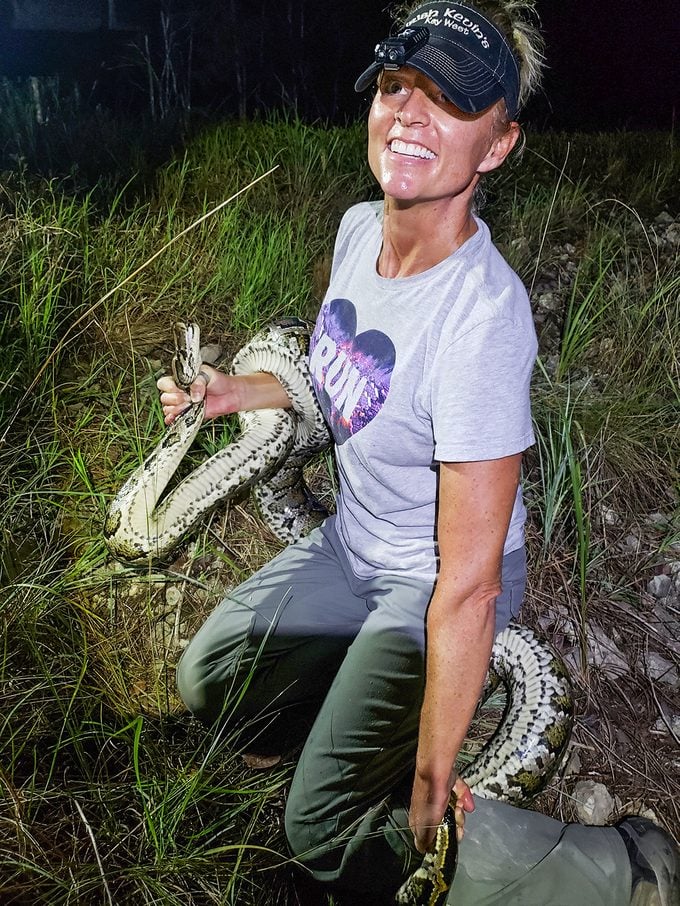
“Right there, I was hooked,” Siewe says. She went back to Indiana and told her fiancé they were moving to Florida.
In a bit of a catch-22, to become a licensed python hunter, Siewe had to show she had experience hunting pythons. But by volunteering to help Kalil catch snakes, she picked up the necessary experience. Now she ventures out looking for pythons about four times a week, mostly in Big Cypress National Preserve. Sometimes she goes on foot, sometimes by car, sometimes by canoe. She and a partner paddle out to islands in the swamp, hop out, grab any snakes they see, and then load them into the canoe to take back.
“One time we got seven pythons, one of them 15 feet long,” she says. A snake that size weighs around 140 pounds. “The canoe was so low to the water we could not have put in another snake.”
Recently, the state has tried using dogs and a new type of camera with infrared technology mounted on drones to sniff out the elusive snakes, but with little luck. The problem with the dogs, says Siewe, is that they’re at risk of being gobbled up by alligators. As for souped-up drones, they can’t spot the pythons if they’re hidden beneath the earth.
“They burrow,” Siewe says. “A lot of their nests are underground. You can be standing right on top of a python and not see it.” That’s why the only way to catch them is the slow, low-tech way: hiring hunters like Siewe to search for them for hours on end and then grab them by hand and stuff them into a bag.
And that’s fine by Gorden-Vega. She can’t picture herself ever quitting. Python hunting, she explains, “becomes a part of you. You think, It’s warm tonight, I’ve got to go out. You get an itch.”